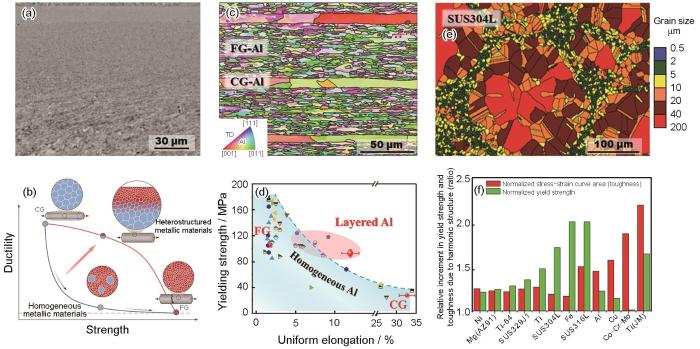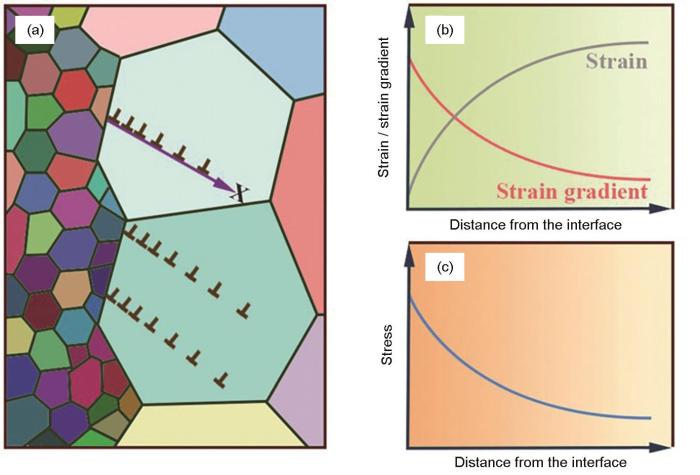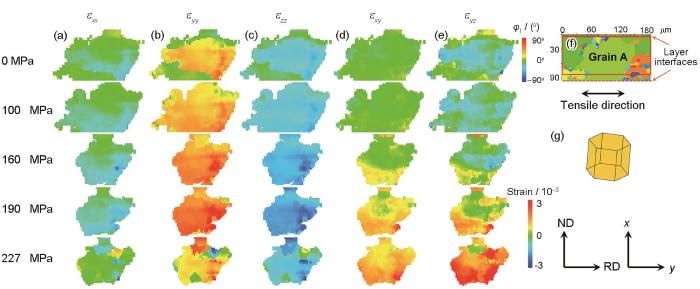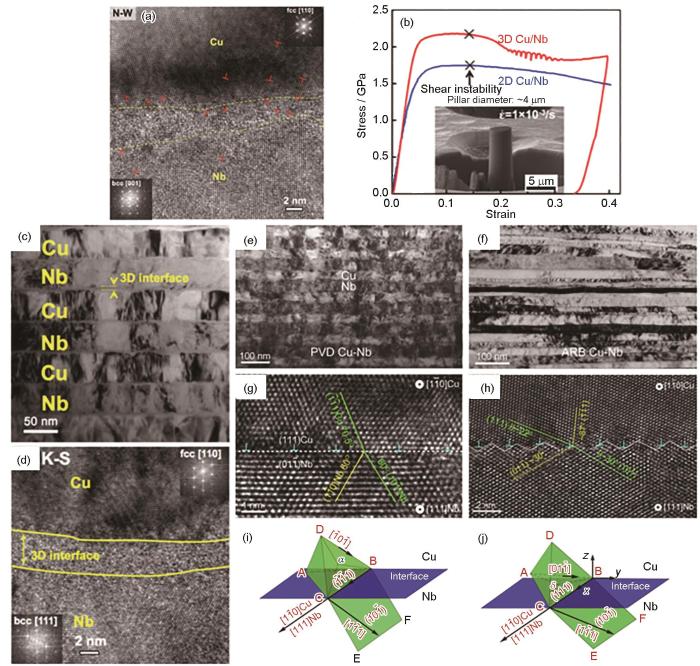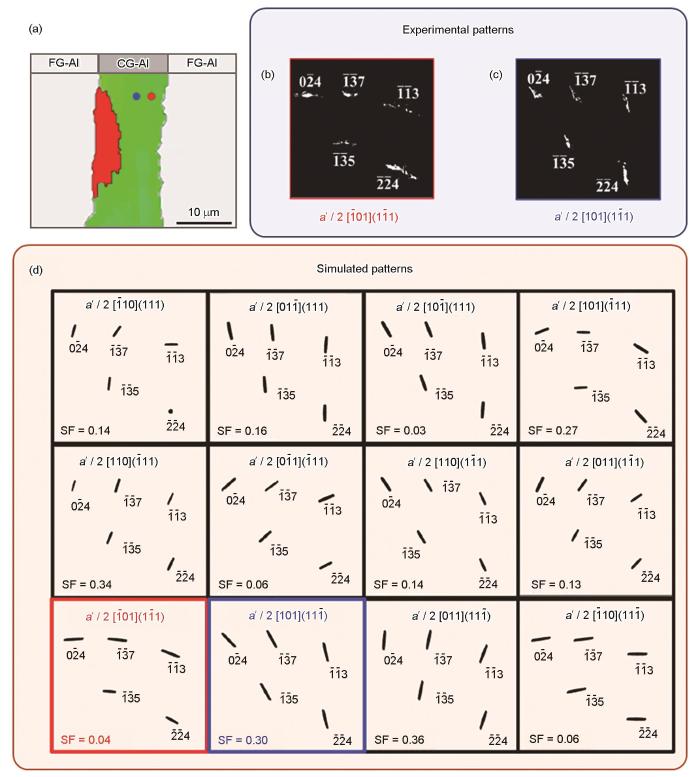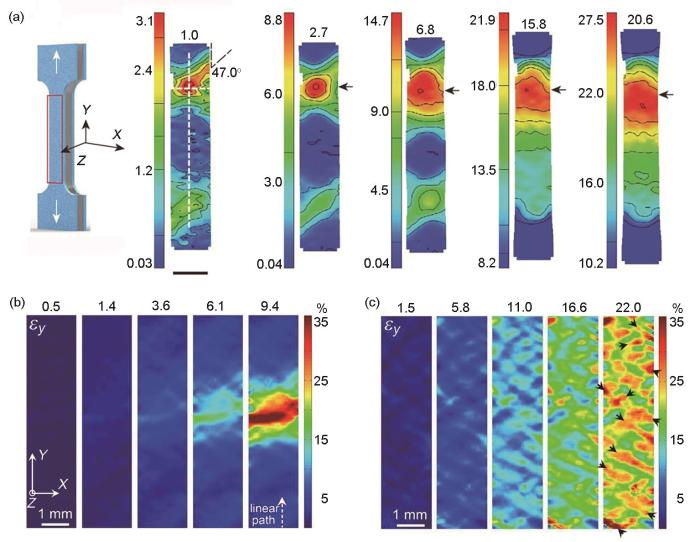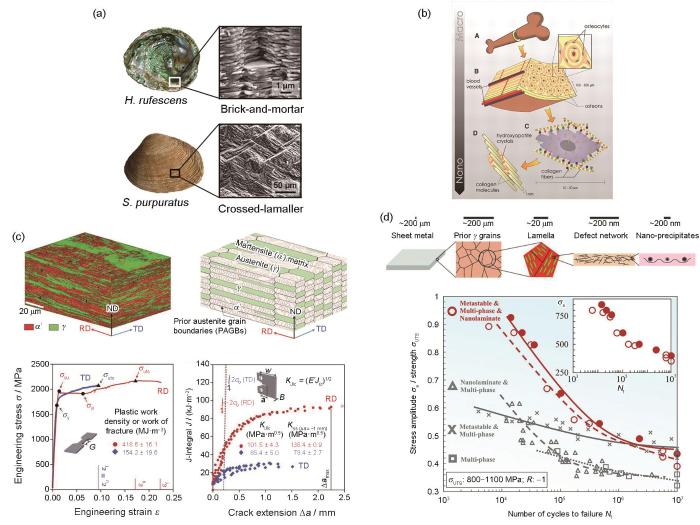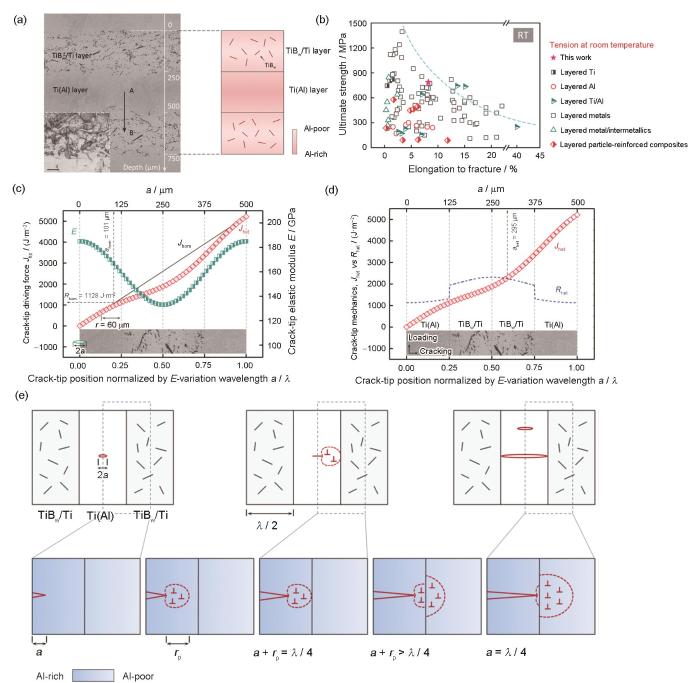金属材料是人类文明的支柱之一,青铜时代、铁器时代等均以冶炼和制造金属工具为显著标志。现代金属材料研究领域中,材料科研工作者们追求使金属同时具有轻质、高强度、高塑韧性等优异综合性能。轻质高强可实现构件轻量化,提高交通、航空航天等领域的运输效率,节能减排;高塑韧性则有利于材料的加工成型,实现复杂形状部件成型,同时保障部件的服役安全性,避免造成重大经济损失和人员伤亡[1,2]。在金属材料学发展的近百年时间里,人们发现并基于经典的4大强化机制(固溶强化、加工硬化、细晶强化和第二相强化)改善金属材料的力学性能。然而,这些手段在优化材料强度的同时往往伴随着塑韧性的降低,材料的力学性能遵循“香蕉曲线”[3,4]。
自然界中存在大量具备优异综合性能的材料,它们成为指导人造金属材料综合性能提升的良好范例[5,6]。例如,生物贝壳中特殊叠层结构组合的无机质比简单结构无机质的断裂韧性高出3个数量级。近年来,在充分挖掘金属材料微观组织设计潜力的基础上,异构设计(heterostructured architecture)的理念被提出并广受关注[7,8]。异构金属材料中包含力学性能差异显著的组元,并且组元的分布遵循特定的空间结构[9],诸如,梯度结构[10~12]、层状结构[13~15]、谐波结构[16,17]、双联通结构[18]等。图1a[19]所示为通过表面塑性变形技术制备晶粒尺寸呈梯度分布的纯Cu,强度提升时大幅缓解了塑韧性的降低,梯度异构Cu的力学性能超越了均匀金属材料的“香蕉曲线”,在强度-塑性坐标空间内向右上角迁移(图1b[19])。广义上,可以将这种优异强度和塑性的组合视为实现了金属材料的“强韧化”。如图1c和d[15]所示,通过热压和轧制工艺,将晶粒尺寸存在较大差异的纯Al进行层状结构复合后,其力学性能同样超越了均匀结构纯Al。利用气流研磨机实现对粉末颗粒的可控剧烈塑性变形后,结合热压烧结可以制备如图1e[16]所示的谐波结构:空间上超细晶三维网壳结构包覆着粗大晶粒。谐波结构设计已经在钢、钛合金、铜合金、高熵合金等多种材料体系中实现应用,同步提升了金属材料的强度和韧性(图1f[16])。
图1
图1
几种典型的异构设计策略及其强韧化效果[15,16,19]
Fig.1
Typical heterostructured architectures and their effects on strength and ductility synergy
(a, b) gradient heterostructure (FG and CG are referred to fine grain and coarse grain, respectively)[19] (c, d) layered heterostructure (TD—transverse direction)[15] (e, f) harmonic heterostructure[16]
异构金属材料中实现了多元微观组织(晶粒尺寸差异、物相差异、成分差异等)的空间分布控制,这一分布控制将对材料产生2个方面的影响:① 在不承受载荷时,由于多元微观组织的差异性(屈服强度、弹性模量、膨胀系数、晶体取向等)在材料内部产生局域残余应力,这些局域应力将会直接影响材料的力学特性[20,21];② 当承受外载荷时,同样由于微观组织和性能的差异性,不同组元的弹性变形、塑性变形及断裂行为不同。作为一个整体,在材料的不同宏观变形阶段,材料内不同的位置可能同时存在弹性变形、塑性变形及微裂纹等,异构设计事实上调控了不同组元在不同宏观变形阶段的局域应变的分布与演化,进而影响材料的宏观力学性能[22,23]。如图2a[9]所示,在早期变形阶段,异构金属材料中软相组元和硬相组元先保持弹性变形,随着外加载荷的逐步增加,异构金属材料中较软的组元将优先屈服,而硬相组元仍然保持弹性变形;直至外加载荷使硬相组元也屈服,进入塑性变形阶段。图2b[24]为通过中子衍射原位实验得到的Ti/Al层状异构材料中不同物相的晶格应变,可清晰地观察到与多阶段变形理论吻合的晶格应变演化规律。
图2
阐明异构设计实现金属材料强韧化的主流理论包括:异构变形诱导强化理论(hetero-deformation induced hardening)[25,26]、应变分配理论(strain partition)[17,27]、延迟颈缩理论(delaying premature local necking)[28,29]、界面影响区理论(interface affected zone)[30]等,上述理论在众多异构设计范例中很好地关联了“微观组织-变形行为-强韧化”,它们的共性之一在于都强调了局域应力与局域应变对于异构金属材料力学性能提升的重要作用。例如,异构变形诱导强化理论中认为软相组元和硬相组元的变形不匹配将引起局域应变梯度,需要几何必需位错(geometrically necessary dislocation,GND)的累积以实现协调,而位错的累积将诱发局域应力状态的改变,从而影响软相和硬相的变形行为。本文聚焦异构金属材料的局域应力和局域应变演化,归纳了异构金属中变形行为、断裂行为与局域应力、局域应变的交互关系及对力学性能的影响,为高性能异构金属材料的设计和研发提供新的思路。
1 早期变形阶段
早期变形阶段主要涉及异构金属材料的弹性变形以及早期的塑性变形,局域应力/应变的分布与演化直接影响了屈服强度及早期形变微结构。均匀金属材料中微观尺度上塑性变形机制(位错滑移、孪生等)的大量激活对应宏观尺度的屈服行为,因而屈服强度一方面取决于塑性变形机制的临界分切应力(critical resolved shear stress,CRSS)的大小,另一方面取决于分切应力是否达到CRSS。CRSS受晶体结构、纯度、温度、应力状态等因素的影响。以应力状态为例,Spitzig[31]发现单晶Fe和多晶钢在三向静水压应力状态下的CRSS提高,使材料得以强化;Zhou等[32]研究指出,高水平的三向静水压应力可以提升纳米晶纯Ni中晶界迁移与滑动的CRSS,有效抑制由位错主导到晶界迁移与滑动主导的形变机制转变,使纳米晶纯Ni的强度提升至5 GPa。尽管异构金属材料的组元往往处于复杂应力状态,其CRSS可能与均匀金属材料存在差异,但目前在异构金属材料中通过直接设计和调控CRSS实现材料强化的案例较少。
异构金属材料的分切应力受到多个因素影响:首先,组元性质各异,由于热膨胀、塑性变形能力等不匹配,在制备过程中易形成高水平局域残余应力[33]。Long等[21]研究发现,表层具有局域残余压应力的梯度纳米晶Cu在循环加载过程中,拉伸强度和压缩强度不对称,而退火后拉压不对称性减弱。Yang等[20]通过同步辐射实验发现,在外加拉应力过程中,具有最高水平局域残余压应力的区域弹性阶段更长。换言之,局域残余压应力抵消了一部分作用于该区域的外加应力。其次,异构金属材料中组元模量差异在弹性变形阶段导致了局域应力的分区[24]。Huang等[24]在Ti/Al层状异构材料、Huang等[30]和Ma等[34]在铜/青铜层状异构材料中均发现,在软相层已经进入塑性变形阶段时,硬相层仍处于弹性阶段,此时材料中主要由硬层承担应力。尽管软相组元已发生塑性变形机制的激活,异构金属材料的宏观屈服往往发生于硬相组元屈服后,硬-软相组元的弹-塑性变形不匹配也将影响分切应力。对铜/黄铜[35,36]、非均质片层钛[37]等异构金属材料形变机制的研究发现,软相组元的早期塑性变形会在异构界面附近产生GND以协调局域应变梯度,这些GND在界面附近软相组元一侧塞积,从而改变了界面附近区域的局域应力状态,并形成了长程应力场,实现材料屈服强度的提升[8,9,25,26,35~38] (图3[9])。Pan等[39]通过循环扭转的方法制备了纳米位错胞结构呈非均匀梯度分布的稳定单相高熵合金Al0.1CoCrFeNi,纳米尺度的低角晶界位错胞提供了与高角晶界相当的强化效果,其屈服强度可达细晶/粗晶组元的2~3倍。在循环加载实验中测得样品在宏观应变量为0.6% (接近屈服)时,背应力高达260 MPa,接近屈服强度的50%。Li等[40]通过热压的方法在纯Ti中实现了粗晶和细晶呈层状分布的结构,其屈服强度与细晶一致。通过对粗/细晶层状异构纯Ti板晶格偏应变的分布与演化(图4[40])及早期形变后位错组态的分析发现,由于层状结构与晶粒取向之间的几何关系以及具有hcp结构的纯Ti的变形机制,层界面附近将发生大量的位错塞积,从而产生背应力,抑制已激活的滑移系继续发射位错。随外加应力增加,层界面附近将持续累积局域应力,直至分切应力使高CRSS的<c + a>位错或相邻细晶中的位错开始运动。此外,由于不同的塑性变形机制贡献的应变张量不同[41],改变组元变形机制也将直接影响局域应变的分布和演化。
图3
图4
图4
粗/细晶层状异构纯Ti板的晶格应变演化[40]
Fig.4
The evolution of lattice strain for grain A in layered heterostructured pure titanium with alternating coarse- and fine-grain layers[40] (φ1—Euler angle)
(a) εxx, the strain component along normal direction (ND, x axis)
(b) εyy, the strain component along rolling direction (RD, y axis)
(c) εzz, the strain component perpendicular to ND and RD (z axis)
(d) εxy, the shear strain component in the x-y plane
(e) εyz, the shear strain component in the y-z plane
(f) Euler angle map of grain A
(g) orientation schematic diagram of grain A
值得一提的是,异构界面的结构也可以影响分切应力,进而显著改变材料的屈服强度。Chen等[42]通过改变物理气相沉积的速率,调节界面结构和化学成分的梯度,实现了组元之间的错配界面的尺度从几纳米到几十纳米的调控。相较于具有2D界面的Cu/Nb层状异构材料,10 nm厚的3D界面使异构金属材料的屈服强度增加了50% (图5[42,43])。通过原子尺度的模拟与分析,位错源可能出现在界面扭曲最强的位置,而不仅取决于Schmid因子。可动位错的形核主要发生在2D界面,2D界面为局域应力集中源[43]。相比之下,3D界面的局域应力集中位置更为分散,需要更大的外加应力使位错从3D界面发射,从而使得材料的屈服强度得以提升。
图5
图5
具有3D界面的Cu/Nb层状异构材料的组织表征与力学性能[42,43]
Fig.5
The microstructures and properties of Cu/Nb layered heterostructured material with 3D interface[42,43]
(a) a high density of dislocations at 3D interface[42]
(b) stress-strain plots for micropillar compression[42] (
异构金属材料局域应力/应变在早期变形阶段的特点可以归纳如下:加载前局域应力分布不均匀(局域残余应力),加载过程中局域应力演化不均匀(组元模量、弹-塑性阶段等差异导致局域应力分区);在弹性变形阶段,各组元的局域应变均线性增加,当软相组元屈服后在异构界面附近形成局域应变梯度。局域应力与局域应变是交互影响的,例如局域应力通过改变变形机制影响局域应变演化,与此同时,局域应变梯度需要GND协调,反过来影响了局域应力状态等。因此,理解异构金属材料屈服强度的提升及早期形变微结构的形成需要综合考虑局域应力和局域应变的影响。
2 塑性变形阶段
前已述及异构设计影响了组元的局域应力状态[44,45],因而异构金属材料在塑性变形阶段的变形机制往往显著区别于均匀金属材料。Wu等[46,47]发现梯度异构材料在宏观单向拉伸过程中,微观上纳米晶表层和粗晶芯部均处于多向局域应力状态。这是由于塑性变形阶段纳米晶表层优先发生塑性失稳而产生侧向收缩,与粗晶芯部的均匀变形不协调,诱发侧向的局域应力分量。多向局域应力状态激活了更多滑移系的启动,促进了位错间的交互和缠结。Cheng等[48]基于微观结构分析与分子动力学计算模拟,发现梯度纳米孪晶Cu在变形初期将形成独特的位错结构:大量GND富集束。位错富集束中超高的位错密度在变形过程中显著提升了梯度纳米孪晶Cu的加工硬化能力。这一设计策略同样适用于高熵合金[39],通过在晶粒内引入尺寸呈梯度分布的位错胞稳定结构,在塑性变形阶段将激活大量细小的层错和孪晶生成,贡献优异的塑性和加工硬化能力。Xia等[15]利用对位错类型敏感的同步辐射X射线白光Laue微衍射技术对层状异构材料中的变形机制进行了细致研究。图6a[15]为Al/Al层状异构材料中粗晶层部分区域的取向示意图,选择其中2点进行Laue微衍射得到衍射花样图6b和c[15]。Laue微衍射的衍射花样与观测区域的位错结构密切相关,当观测区域存在GND时,衍射斑点形状拉长,拉长方向与GND对应的滑移系相关[49]。基于刃型位错开动模拟fcc金属开动不同滑移系时的衍射花样(图6d[15]),比对标定层状异构材料中的Al启动了[
图6
图6
利用同步辐射X射线白光Laue微衍射技术分析Al/Al层状异构材料中的变形机制[15]
Fig.6
Analyses of deformation mechanism in Al/Al layered heterostructured materials by synchrotron radiation polychromatic X-ray Laue microdiffraction[15]
(a) inverse pole figure map (b, c) Laue patterns taken from the red and blue points marked in Fig.6a (d) simulations of Laue peak streaking directions corresponding to all the 12 possible slip systems (a'—lattice constant, SF—Schmid factor)
在塑性变形阶段,异构金属材料中独特的局域应力分布和演化促进了多种变形机制的协同激活,有利于位错-位错、位错-孪晶等交互过程,因而提升了异构金属材料的加工硬化能力,即变形过程中单位应变增量下应力的提升(dσ / dε,其中σ为应力,ε为应变)。依据Hart和Considére准则[51,52],高加工硬化能力对于稳定材料的塑性变形能力有积极意义,已有众多研究通过数据图像相关技术(digital image correlation,DIC)验证了异构设计对局域应变的优化作用[53~57]。例如,均匀纳米晶材料由于缺乏加工硬化能力,往往形成细长的剪切带迅速贯穿样品导致失效。Yuan等[58]在梯度结构的无间隙原子钢中发现,梯度结构使纳米晶层表面的早期剪切带沿着加载方向发生扩展,演化成局域应变集中区域(图7a[58])。当变形集中于剪切带时,金属材料实际参与变形的区域远小于样品的标距。通过剪切带的非局域化,拓展参与变形的区域,可为位错、孪晶等的形成、储存和交互提供充分的空间。Wang等[59]对比了纳米晶层单独承载时(图7b[59])和有梯度结构支持时(图7c[59])的局域应变演化,指出异构设计对剪切带有稳定作用,促进了大量分散分布的剪切带形成。这一现象在众多材料体系中均得到验证[60~62],表明该设计策略具备普适性。值得一提的是,剪切带中的应变集中将诱发晶粒粗化和位错等缺陷的湮灭,为位错、孪晶等的后续形成和存储提供空间,进而进一步协助稳定塑性变形[63];另一方面,剪切带区域和非剪切带区域间相互约束的切应变分量也有促进非剪切带区域塑性变形的作用[59]。通过异构设计稳定或者非局域化应变集中,有助于提升材料的综合力学性能。
图7
Fig.7
Delocalization of shear bands achieved by gradient heterostructure[58,59]
(a) contour maps of axial strain on nanostructured surface (X, Y, and Z are referred to transverse direction, loading direction, and normal direction, respectively)[58]
(b) contour maps of axial strain on freestanding nanostructured surface (εy —strain component along loading direction)[59]
(c) contour maps of axial strain on nanostructured surface supported by gradient heterostructured substrate[59]
综上所述,在塑性变形阶段,异构金属的局域应力/应变的分布和演化通常是不均匀的,贡献异构金属材料优异加工硬化能力的因素主要包括:① 复杂局域应力状态激活了均匀金属材料中难启动的变形机制;② 通过改善局域应变分布,抑制局域应变集中及其诱发的过早失效。上述2个因素共同促进了位错、层错、孪晶等的增殖和交互,一方面提高了异构金属材料的加工硬化能力,另一方面延长了异构金属材料的加工硬化阶段。
3 断裂行为特点
前文已讨论了异质结构金属在早期变形阶段和塑性变形阶段中局域应力/应变和特征变形机制之间的关系,并指出局域应力/应变是解释异构金属材料强度-塑性优异组合的关键。强度-塑性的改善使异构金属材料具备更优异的韧性和抵抗失效的能力。因此,探究异构金属材料的断裂失效行为及其与力学性能的关系十分重要。
异构设计提升韧性的案例在大自然中随处可见,例如海边的贝壳[67,68] (图8a[68])和人的牙齿[69]、骨骼[70,71] (图8b[71])等。这些自然界中高断裂韧性的材料具备一个共同特征:微-纳米尺度的硬相和软相交替堆叠而形成“砖瓦结构”(brick-and-mortar structure)[72]。贝壳是由较硬的矿物质和较软的有机蛋白质交替形成[67];骨骼的基本单元则是由羟基磷灰石和胶原蛋白复合而成[73]。基于自然界的启示和对异构材料断裂机制的深入认识,近年来,科研工作者们在大量传统材料体系中实现了异构设计的应用和发展,通过硬相和软相在介-微观多级尺度的构型设计实现了材料整体强韧性的大幅度提高。Liu等[74]通过简单的热变形-淬火配分方法制备了双相超强钢,该材料在抗拉强度超过2 GPa的同时保持了20%的拉伸延伸率(图8c[74])。该双相钢是由片层状分布的马氏体基体和亚稳的奥氏体组成,与贝壳的微观结构相似,研究发现亚稳奥氏体的相变诱发塑性机制(transformation-induced plasticity,TRIP)和界面开裂效应(delamination)共同作用,有效地提高了金属的强韧性。Koyama等[73]受到骨骼结构的启发,开发了由硬的马氏体片层和软的亚稳奥氏体组成的多级纳米片层的双相钢,指出多级纳米片层结构对裂纹的偏转引起了粗糙度诱导裂纹终止(roughness-induced crack termination,RICT)机制,而亚稳奥氏体转变为马氏体的过程中产生的体积变化将引入局域压应力从而限制裂纹的形核和扩展,即相变诱导裂纹终止(transformation-induced crack termination,TICT)机制。RICT和TICT 2种机制的共同作用可最大程度抑制疲劳裂纹的扩展过程,因此该异构金属材料的疲劳韧性明显优于传统的双相钢(图8d[73])。高熵合金因具有区别于传统合金的优异综合性能受到广泛关注[75],而通过多级异构设计的强韧化方案同样在共晶高熵合金中获得成功的应用和实践。Shi等[76]采用定向凝固方法设计并制备了一种仿生鱼骨结构的共晶高熵合金,在不牺牲强度的情况下,获得了超高的断裂韧性。研究发现超高断裂韧性是由于共晶片层中B2相容纳了大量微裂纹,这些微裂纹在片层界面处发生明显钝化不进入L1软相,多级层状结构的缓冲机制进一步抑制了微裂纹的扩展,使材料表现出极强的塑性变形能力和断裂韧性。
图8
Fig.8
Cases of heterostructures in nature and applications
(c) microstructure and mechanical properties of ultrastrong dual-phase steel (σy—yield strength, σyu—upper yield strength, σyl—lower yield strength, σuts—ultimate tensile strength, εu—uniform elongation, εf—fracture elongation, G—gauge length, σ0—effective yield strength, KJIC—crack-initiation fracture toughness, Kss—crack-growth toughness, E'—effective modulus, JIC—size-independent fracture toughness, Δamax—maximum length for stable crack extension, B—specimen thickness, W—specimen width, a—crack length)[74]
(d) microstructure and fatigue properties of bone-like heterostructured steel (R—stress ratio)[73]
众多研究案例指出,异构设计大幅阻碍了异构金属材料中微裂纹的扩展,提高了对微裂纹的容纳能力[53,54,56]。微裂纹萌生后并不会迅速扩展贯穿材料导致完全失效,因此,微裂纹也成为了异构金属材料中协调变形的“变形机制”[23,57]。异构金属材料的断裂行为同样可以归纳为异构设计对局域应力/应变的影响。Wu等[14]通过粉末烧结-热压复合工艺制备了TiBw/Ti-Ti(Al)层状异构材料。如图9a和b[14]所示为层状异构材料的微观组织及力学性能,该层状异构材料由TiB晶须增强Ti层(TiBw/Ti)和固溶Al元素的Ti层(Ti(Al))交替堆叠而成。微裂纹的形核和扩展与局域应力密切相关,图9c和d[14]中考虑了层状结构对裂纹尖端的驱动力(Jhet)和对裂纹扩展的抵抗力(Rhet)的影响,相比于均匀金属材料的裂纹驱动力(Jhom),层状结构使Ti(Al)层中形核的微裂纹在TiBw/Ti层中的裂纹驱动力(Jhet)明显降低。图9e[14]所示为微裂纹扩展过程示意图。当Ti(Al)层中微裂纹尖端前的塑性区到达TiBw/Ti层时,虽然裂纹还没进入相邻层,但较软的TiBw/Ti层具有更低的裂纹驱动力(图9c[14])和更高的裂纹抵抗力,抑制了微裂纹的进一步扩展(图9d[14])。此外,裂纹尖端区域往往存在更加复杂的多向局域应力状态[77],有利于促进裂纹尖端的塑性区内开动不常见的位错机制。位错的交互作用使得塑性区快速硬化,起到钝化裂纹的作用[78]。与此同时,异构金属材料内部大量容纳的微裂纹同样贡献了局域拉伸应变,使得异质结构金属表现出极高的断裂延伸率[24,54]。
图9
图9
TiBw/Ti-Ti(Al)层状异构材料的断裂行为研究[14]
Fig.9
Fracture analyses of TiBw/Ti-Ti(Al) layered heterostructured materials[14]
(a) microstructure (b) comparisons of tensile properties (c, d) effect of layered heterostructure on crack driving force and crack resistance (Jhom—crack-tip driving force for homogeneous structure, Jhet—crack-tip driving force for heterogeneous structure, Rhom—resistance to crack propagation for homogeneous structure, Rhet—resistance to crack propagation for heterogeneous structure, ahom—half of critical crack length for homogeneous structure, ahet—half of critical crack length for heterogeneous structure, r—affected zone size of heterogeneous interface) (e) schematic diagram of the effect of layered heterostructure on the plastic zone at the microcrack tip (rp—plastic zone size at the microcrack tip)
异构金属材料断裂行为与局域应力/应变的关系可以归纳为:异构设计调控的局域应力通过影响裂纹扩展的驱动力和抵抗力、激活裂纹尖端塑性区域多种变形机制等途径,实现对微裂纹扩展的抑制,有效稳定材料内部的微裂纹。不易扩展的微裂纹起到了提供局域应变、协调局域应变分布的作用。值得一提的是,结合不同材料体系中可能存在的特殊机制,如相变诱导塑性、孪生诱导塑性、相变诱导残余应力等,可进一步提高异构金属材料的强度-韧性匹配,该类过程中局域应力/应变的分布和演化行为也更为复杂。然而,该方面研究目前主要集中于适用材料体系的扩展和微观结构参数实验试错等方向。大量研究发现,异构金属材料的微观组织特征,如硬相-软相的尺寸[79]、硬相-软相的比例[80]、硬相-软相的分布方式[81]、位向[82]等,均会影响异构金属材料的断裂失效行为,如何优化异构设计方案以实现最优的强度-塑/韧性结合亟需系统研究,并发展具有普适性的研发策略,这可能需要在实验的基础上进一步结合断裂力学[83,84]、塑性力学[85~87]等数值模拟方法进行预测和完善。此外,由于异构设计本征的空间特征,异构金属材料往往存在较为明显的各向异性,但该方面的研究尚不全面。例如梯度异构材料的力学性能大多仅从垂直于梯度方向的拉伸实验获得、层状异构材料的力学性能研究主要基于平行于层方向的拉伸实验或垂直于层方向的弯曲实验展开等。系统探明异构金属材料的各向异性,并结合材料的实际服役力学条件进行异构设计优化,也是亟待研究和发展的重要方向。
4 结论与展望
异构金属材料中异质组元对力学的响应不同,导致受载过程中相互约束,有效调控了组元的局域应力、局域应变。异构金属材料中局域应力和局域应变的分布和演化贯穿了早期变形阶段、塑性变形阶段和断裂阶段,异构设计对局域应力的有效调控,是异构金属材料表现出区别于均匀金属材料的塑性变形机制、断裂机制等的关键因素,变形机制和断裂机制的改变一方面表现为微观组织的演化过程,另一方面影响了变形、断裂机制提供的局域应变,表现为调控、优化了异构金属材料中的局域应变分布和演化。值得关注的是,异构金属材料中往往同时存在多种变形机制、断裂机制的交互作用,协同实现了对异构金属材料加工硬化能力、损伤容限、断裂延伸率的改善,从而贡献了异构金属材料优异的强度、塑性和韧性。未来的研究方向主要包括2个方面。
(1) 微观组织设计优化与可控制备:气相沉积、增材制造、精密铸轧、智能制造等技术和领域的蓬勃发展,为金属材料中复杂构型的设计制备、跨尺度的异构构筑等提供了更多可能,有望进一步提升异构金属材料性能极限。与此同时,如何将异构设计与工业设备耦合,发展、实现工业规模生产的制备技术也是亟待拓展的方向之一。
(2) 局域应力与局域应变表征和解析:目前局域应变可以通过DIC、电子背散射衍射技术等方法实验表征,局域应力的实验量化研究较为有限。通过发展局域应力/应变表征技术,耦合有限元模拟、晶体塑性理论等模拟方法,解析局域应力/应变与异构金属材料变形/断裂行为的相关性,有望丰富和拓宽金属材料异构设计理论,指导高性能异构金属材料研发。
参考文献
Fcc nanostructured TiFeCoNi alloy with multi-scale grains and enhanced plasticity
[J].
Review on superior strength and enhanced ductility of metallic nanomaterials
[J].
Nanostructured high-strength molybdenum alloys with unprecedented tensile ductility
[J].The high-temperature stability and mechanical properties of refractory molybdenum alloys are highly desirable for a wide range of critical applications. However, a long-standing problem for these alloys is that they suffer from low ductility and limited formability. Here we report a nanostructuring strategy that achieves Mo alloys with yield strength over 800 MPa and tensile elongation as large as ~ 40% at room temperature. The processing route involves a molecular-level liquid-liquid mixing/doping technique that leads to an optimal microstructure of submicrometre grains with nanometric oxide particles uniformly distributed in the grain interior. Our approach can be readily adapted to large-scale industrial production of ductile Mo alloys that can be extensively processed and shaped at low temperatures. The architecture engineered into such multicomponent alloys offers a general pathway for manufacturing dispersion-strengthened materials with both high strength and ductility.
Materials become insensitive to flaws at nanoscale: Lessons from nature
[J].
Graded materials for resistance to contact deformation and damage
[J].The mechanical response of materials with spatial gradients in composition and structure is of considerable interest in disciplines as diverse as tribology, geology, optoelectronics, biomechanics, fracture mechanics, and nanotechnology. The damage and failure resistance of surfaces to normal and sliding contact or impact can be changed substantially through such gradients. This review assesses the current understanding of the resistance of graded materials to contact deformation and damage, and outlines future research directions and possible applications for graded materials.
Gradient and lamellar heterostructures for superior mechanical properties
[J].
Introduction to heterostructured materials: A fast emerging field
[J].
Heterogeneous materials: A new class of materials with unprecedented mechanical properties
[J].
Heterostructured bulk aluminum with controllable gradient structure: Fabrication strategy and deformation mechanisms
[J].
Gradient nanotwinned CrCoNi medium-entropy alloy with strength-ductility synergy
[J].
Unraveling the origin of extra strengthening in gradient nanotwinned metals
[J].
Thickness-dependent shear localization in Cu/Nb metallic nanolayered composites
[J].
Temperature-dependent reversed fracture behavior of multilayered TiBw/Ti-Ti(Al) composites
[J].
Superior strength-ductility synergy of layered aluminum under uniaxial tensile loading: The roles of local stress state and local strain state
[J].
Three-dimensionally gradient harmonic structure design: An integrated approach for high performance structural materials
[J].
Additional hardening in harmonic structured materials by strain partitioning and back stress
[J].
Bi-continuous metal matrix composites
[J].
Making strong nanomaterials ductile with gradients
[J].
Residual stress provides significant strengthening and ductility in gradient structured materials
[J].
Residual stress induced tension-compression asymmetry of gradient nanograined copper
[J].
Plastic strain localization in metals: Origins and consequences
[J].
An overview of tailoring strain delocalization for strength-ductility synergy
[J].
Role of layered structure in ductility improvement of layered Ti-Al metal composite
[J].
Hetero-deformation induced (HDI) hardening does not increase linearly with strain gradient
[J].
Perspective on hetero-deformation induced (HDI) hardening and back stress
[J].
Strain partitioning by recurrent shear localization during equal-channel angular pressing of an AA6060 aluminum alloy
[J].
Delaying premature local necking of high-strength Cu: A potential way to enhance plasticity
[J].
Maximizing necking-delayed fracture of sandwich-structured Ni/Cu/Ni composites
[J].
Interface affected zone for optimal strength and ductility in heterogeneous laminate
[J].
Effect of hydrostatic pressure on plastic-flow properties of iron single crystals
[J].
High-pressure strengthening in ultrafine-grained metals
[J].
Determination of macroscopic and microscopic residual stresses in friction stir welded metal matrix composites via neutron diffraction
[J].
Mechanical properties of copper/bronze laminates: Role of interfaces
[J].
Effect of heterostructure and hetero-deformation induced hardening on the strength and ductility of brass
[J].
In-situ observation of dislocation dynamics near heterostructured interfaces
[J].There has been a long-standing controversy on how dislocations interact with interfaces. Here we report in-situ observations that in a Cu-brass heterostructured TEM film Frank-Read sources are the primary dislocation sources. They were dynamically formed and deactivated throughout the deformation in grain interior, which has never been reported before. This observation indicates that strain gradient near interfaces cannot be quantitatively related to the density gradient of geometrically necessary dislocations, and it was primarily produced by Frank-Read source gradient instead of dislocation pile-ups. These findings provide new insights on how to design heterostructured interfaces to enhance mechanical properties. [GRAPHICS]
Heterogeneous lamella structure unites ultrafine-grain strength with coarse-grain ductility
[J].
Ductility and strain hardening in gradient and lamellar structured materials
[J].
Gradient cell-structured high-entropy alloy with exceptional strength and ductility
[J].
Enhanced strength in pure Ti via design of alternating coarse- and fine-grain layers
[J].
Review of the Taylor ambiguity and the relationship between rate-independent and rate-dependent full-constraints Taylor models
[J].
Effects of three-dimensional Cu/Nb interfaces on strengthening and shear banding in nanoscale metallic multilayers
[J].
Plastic instability mechanisms in bimetallic nanolayered composites
[J].
Micromechanical behavior of multilayered Ti/Nb composites processed by accumulative roll bonding: An in-situ synchrotron X-ray diffraction investigation
[J].
In-situ synchrotron X-ray micro-diffraction investigation of ultra-low-strain deformation microstructure in laminated Ti-Al composites
[J].
Extraordinary strain hardening by gradient structure
[J].
Synergetic strengthening by gradient structure
[J].
Extra strengthening and work hardening in gradient nanotwinned metals
[J].
Progress of in situ synchrotron X-ray diffraction studies on the mechanical behavior of materials at small scales
[J].
Unexpected de-twinning of strongly-textured Ti mediated by local stress
[J].The local stress tailored by a layered structure is believed to have a crucial influence on the mechanical properties of layered metals, but the correlation between local stress and deformation mechanism is still ambiguous. In the present work, a quantitative analysis of the twinning behavior of Ti in Ti-Al layered metal was conducted by means of electron backscatter diffraction (EBSD) coupled with in-situ tensile tests. Upon the uniaxial tensile loading, an unconventional de-twinning of $\left\{ 10\bar{1}2 \right\}\langle 10\bar{1}\bar{1}\rangle $ extension twin in Ti was observed instead of the expected $\left\{ 11\bar{2}2 \right\}\langle 11\bar{2}\bar{3}\rangle $ contraction twinning. This observation could be attributed to the multiaxial local stress in Ti induced by the layered structure and to differences in the local deformation accommodation among twinning modes. The local Schmid factor (LSF) that considers local stress, and the displacement gradient tensors of twinning provided insights into the twinning behaviors of Ti in Ti-Al layered metal.
High tensile ductility in a nanostructured metal
[J].
Towards strength-ductility synergy through the design of heterogeneous nanostructures in metals
[J].
Revealing extraordinary tensile plasticity in layered Ti-Al metal composite
[J].Layered Ti-Al metal composite (LMC) fabricated by hot-pressing and hot-rolling process displays higher ductility than that of both components. In this paper, a combination of digital image correlation (DIC) and X-ray tomography revealed that strain delocalization and constrained crack distribution are the origin of extraordinary tensile ductility. Strain delocalization was derived from the transfer of strain partitioning between Ti and Al layer, which relieved effectively the strain localization of LMC. Furthermore, the extensive cracks of LMC were restricted in the interface due to constraint effect. Layered architecture constrained the distribution of cracks and significantly relieved the strain localization. Meanwhile, the transfer of strain partitioning and constrained crack distribution were believed to inhibit the strain localization of Ti and change the deformation mechanisms of Ti. Our finding enriches current understanding about simultaneously improving the strength and ductility by structural design.
High elongation achieved by band-like distribution of reinforcements in aluminum matrix composites
[J].
Deformation behavior of ultra-strong and ductile Mg-Gd-Y-Zn-Zr alloy with bimodal microstructure
[J].
Improving the tensile ductility of metal matrix composites by laminated structure: A coupled X-ray tomography and digital image correlation study
[J].
Manipulating the plastic strain delocalization through ultra-thinned hierarchical design for strength-ductility synergy
[J].
Ductility by shear band delocalization in the nano-layer of gradient structure
[J].
Activating dispersed strain bands in tensioned nanostructure layer for high ductility: The effects of microstructure inhomogeneity
[J].
Heterostructure induced dispersive shear bands in heterostructured Cu
[J].
Mechanical response of the constrained nanostructured layer in heterogeneous laminate
[J].
Shear band stability and uniform elongation of gradient structured material: Role of lateral constraint
[J].
Dense dispersed shear bands in gradient-structured Ni
[J].
The conflicts between strength and toughness
[J].The attainment of both strength and toughness is a vital requirement for most structural materials; unfortunately these properties are generally mutually exclusive. Although the quest continues for stronger and harder materials, these have little to no use as bulk structural materials without appropriate fracture resistance. It is the lower-strength, and hence higher-toughness, materials that find use for most safety-critical applications where premature or, worse still, catastrophic fracture is unacceptable. For these reasons, the development of strong and tough (damage-tolerant) materials has traditionally been an exercise in compromise between hardness versus ductility. Drawing examples from metallic glasses, natural and biological materials, and structural and biomimetic ceramics, we examine some of the newer strategies in dealing with this conflict. Specifically, we focus on the interplay between the mechanisms that individually contribute to strength and toughness, noting that these phenomena can originate from very different lengthscales in a material's structural architecture. We show how these new and natural materials can defeat the conflict of strength versus toughness and achieve unprecedented levels of damage tolerance within their respective material classes.
In situ synchrotron tomography estimation of toughening effect by semi-ductile fibre reinforcement in a tungsten-fibre-reinforced tungsten composite system
[J].
Intergranular crack-deflection toughening in silicon carbide
[J].
Mechanical strength of abalone nacre: Role of the soft organic layer
[J].The nacreous portion of the abalone shell is composed of calcium carbonate crystals interleaved with layers of viscoelastic proteins. The resulting structure yields unique mechanical properties. In this study, we focus on the thin viscoelastic layers between the tiles and on their role on the mechanical properties of the shell. Both SEM and AFM show that the thin (approximately 30 nm) organic layer is porous, containing holes with diameter of approximately 50 nm. These holes enable the formation of mineral bridges between adjacent tile layers. The mineral bridges play a pivotal role in growth and ensure the maintenance of the same crystallographic relationship through tile growth in the 'terraced cone' mode. The existence of mineral bridges is consistent with the difference between tensile and compressive strength of the abalone. Mechanical tests with loading applied perpendicular to the plane of the organic layers reveal a tensile strength lower than 10 MPa, whereas the compressive strength is approximately 300-500 MPa. These nanoscale bridges have, by virtue of their dimensions (50 nm diameter x 30 nm length), a strength that reaches their theoretical value. The calculated tensile strength based on the theoretical strength predicts a bridge density of approximately 2.25/microm(2). A major conclusion of this investigation is that the role of the organic layer is primarily to subdivide the CaCO(3) matrix into platelets with thickness of 0.5 microm. Its intrinsic effect in providing a glue between adjacent tiles may not be significant.
On the damage tolerance of 3-D printed Mg-Ti interpenetrating-phase composites with bioinspired architectures
[J].Bioinspired architectures are effective in enhancing the mechanical properties of materials, yet are difficult to construct in metallic systems. The structure-property relationships of bioinspired metallic composites also remain unclear. Here, Mg-Ti composites were fabricated by pressureless infiltrating pure Mg melt into three-dimensional (3-D) printed Ti-6Al-4V scaffolds. The result was composite materials where the constituents are continuous, mutually interpenetrated in 3-D space and exhibit specific spatial arrangements with bioinspired brick-and-mortar, Bouligand, and crossed-lamellar architectures. These architectures promote effective stress transfer, delocalize damage and arrest cracking, thereby bestowing improved strength and ductility than composites with discrete reinforcements. Additionally, they activate a series of extrinsic toughening mechanisms, including crack deflection/twist and uncracked-ligament bridging, which enable crack-tip shielding from the applied stress and lead to "Γ"-shaped rising fracture resistance R-curves. Quantitative relationships were established for the stiffness and strengths of the composites by adapting classical laminate theory to incorporate their architectural characteristics.© 2022. This is a U.S. government work and not under copyright protection in the U.S.; foreign copyright protection may apply.
Teeth: Among nature's most durable biocomposites
[J].
The true toughness of human cortical bone measured with realistically short cracks
[J].Bone is more difficult to break than to split. Although this is well known, and many studies exist on the behaviour of long cracks in bone, there is a need for data on the orientation-dependent crack-growth resistance behaviour of human cortical bone that accurately assesses its toughness at appropriate size scales. Here, we use in situ mechanical testing to examine how physiologically pertinent short (<600 microm) cracks propagate in both the transverse and longitudinal orientations in cortical bone, using both crack-deflection/twist mechanics and nonlinear-elastic fracture mechanics to determine crack-resistance curves. We find that after only 500 microm of cracking, the driving force for crack propagation was more than five times higher in the transverse (breaking) direction than in the longitudinal (splitting) direction owing to major crack deflections/twists, principally at cement sheaths. Indeed, our results show that the true transverse toughness of cortical bone is far higher than previously reported. However, the toughness in the longitudinal orientation, where cracks tend to follow the cement lines, is quite low at these small crack sizes; it is only when cracks become several millimetres in length that bridging mechanisms can fully develop leading to the (larger-crack) toughnesses generally quoted for bone.
Exploring and engineering the cell surface interface
[J].Cells are inherently sensitive to local mesoscale, microscale, and nanoscale patterns of chemistry and topography. We review current approaches to control cell behavior through the nanoscale engineering of materials surfaces. Far-reaching implications are emerging for applications including medical implants, cell supports, and materials that can be used as instructive three-dimensional environments for tissue regeneration.
Discrete-element modeling of nacre-like materials: Effects of random microstructures on strain localization and mechanical performance
[J].
Bone-like crack resistance in hierarchical metastable nanolaminate steels
[J].Fatigue failures create enormous risks for all engineered structures, as well as for human lives, motivating large safety factors in design and, thus, inefficient use of resources. Inspired by the excellent fracture toughness of bone, we explored the fatigue resistance in metastability-assisted multiphase steels. We show here that when steel microstructures are hierarchical and laminated, similar to the substructure of bone, superior crack resistance can be realized. Our results reveal that tuning the interface structure, distribution, and phase stability to simultaneously activate multiple micromechanisms that resist crack propagation is key for the observed leap in mechanical response. The exceptional properties enabled by this strategy provide guidance for all fatigue-resistant alloy design efforts.Copyright © 2017, American Association for the Advancement of Science.
Making ultrastrong steel tough by grain-boundary delamination
[J].Developing ultrahigh-strength steels that are ductile, fracture resistant, and cost effective would be attractive for a variety of structural applications. We show that improved fracture resistance in a steel with an ultrahigh yield strength of nearly 2 gigapascals can be achieved by activating delamination toughening coupled with transformation-induced plasticity. Delamination toughening associated with intensive but controlled cracking at manganese-enriched prior-austenite grain boundaries normal to the primary fracture surface dramatically improves the overall fracture resistance. As a result, fracture under plane-strain conditions is automatically transformed into a series of fracture processes in "parallel" plane-stress conditions through the thickness. The present "high-strength induced multidelamination" strategy offers a different pathway to develop engineering materials with ultrahigh strength and superior toughness at economical materials cost.Copyright © 2020 The Authors, some rights reserved; exclusive licensee American Association for the Advancement of Science. No claim to original U.S. Government Works.
Multistage work hardening assisted by multi-type twinning in ultrafine-grained heterostructural eutectic high-entropy alloys
[J].
Hierarchical crack buffering triples ductility in eutectic herringbone high-entropy alloys
[J].In human-made malleable materials, microdamage such as cracking usually limits material lifetime. Some biological composites, such as bone, have hierarchical microstructures that tolerate cracks but cannot withstand high elongation. We demonstrate a directionally solidified eutectic high-entropy alloy (EHEA) that successfully reconciles crack tolerance and high elongation. The solidified alloy has a hierarchically organized herringbone structure that enables bionic-inspired hierarchical crack buffering. This effect guides stable, persistent crystallographic nucleation and growth of multiple microcracks in abundant poor-deformability microstructures. Hierarchical buffering by adjacent dynamic strain-hardened features helps the cracks to avoid catastrophic growth and percolation. Our self-buffering herringbone material yields an ultrahigh uniform tensile elongation (~50%), three times that of conventional nonbuffering EHEAs, without sacrificing strength.Copyright © 2021 The Authors, some rights reserved; exclusive licensee American Association for the Advancement of Science. No claim to original U.S. Government Works.
Dynamical fracture instabilities due to local hyperelasticity at crack tips
[J].
Deformation behavior of brittle/ductile multilayered composites under interface constraint effect
[J].
Micro-macro modelling of the effects of the grain size distribution on the plastic flow stress of heterogeneous materials
[J].
Enhancing co-deformation ability of nanograined Ni-W layers in the Ni/Ni-W laminated composites
[J].
On the exceptional damage-tolerance of gradient metallic materials
[J].
Influence of lamellar orientation on fatigue crack propagation behavior in titanium aluminide TiAl
[J].
Modeling of crack bridging and failure in heterogeneous composite materials: A damage-plastic multiphase model
[J].
Plastic deformation and fracture processes in metallic and ceramic nanomaterials with bimodal structures
[J].
A micromechanical model of toughening behavior in the dual-phase composite
[J].
A uniform multiscale method for 3D static and dynamic analyses of heterogeneous materials
[J].
Plasticity in materials with heterogeneous microstructures
[J].




